|
| |
|
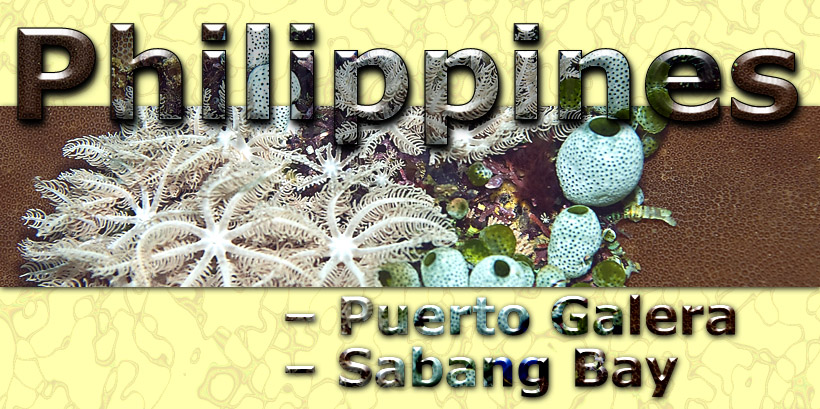 |
|
|
|
Text and Photography by Tom Isgar
I have always wanted to dive in the Philippines. My original instructor in Colorado, Scuba Joe, talked about the Philippines and I was hooked. Thirty years and 30 countries later (January 2011) I made it to Sabang Bay – one of the top ten dive sites in the Philippines. Why did I wait so long?! Of course only diving along 4-5 miles of coast leaves 22,606 more miles to explore. The Philippines has the third longest coastline in the world, after Indonesia and Canada.
This trip could be the beginning of the rest of my dive career.
The Philippines
The Philippines consists of 7,107 islands and islets located in Southeast Asia (longitude: 122° 00 E and latitude: 13° 00 N) surrounded by water. They are between the Pacific Ocean on the east and the South China Sea to the west. The northernmost group of islands is only 118 miles from Taiwan, while the southernmost island is 37 miles away from Borneo.
The total land area of the Philippines is comparable in size to Italy. The population in 2009 was nearly 92 million.
The climate is Tropical with a dry season from November to May and a wet season from June to October and an average year around temperature of 81° Fahrenheit. |
|
|
|
|
The Philippine Peso was exchanging at about 44/$1US
The two official Languages are Pilipino (based on Tagalog) and English. You'll immediately notice that much, most of the signage is English. Be aware that this doesn't translate to easy communication in all situations.
The Government is a Republic with three equal branches Executive, Legislative and Judiciary.
https://www.philippinedomain.com/philippine-facts.htm
|
|
|
|
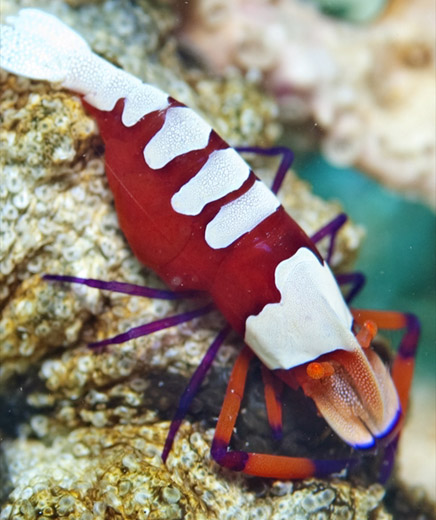 |
Unidentified Parasitic Isopod |
|
|
|
|
Health & Safety
Check with your Doctor about any vaccinations. Malaria is only a potential problem in some remote areas.
There are pharmacies throughout The Philippines and they may have what you need. I visited one but the labels were all in Pilipino and the Pharmacist knew little English. Eventually she found a drug catalog which allowed us to figure out what I needed, for a sore throat and a cough.
Bring prescriptions and your personal choice of OTC medications with you. If you get sick during your visit, there are medical services available.
There are six decompression chambers in the Philippines as well as a roving chamber provided by the Philippine Coast Guard.
Bottled water is cheap and available everywhere.
I didn't experience safety as a big issue, taking the same precautions I would at home, but listen to your hosts and follow local advice. The room in our inclusive resort had a safe we used it, never carrying wallets with us.
For more information: Puerto Galera
https://www.puertogalera.org/ |
|
|
 |
Sabang Beach – outside Atlantis divers |
|
|
|
|
|
|
Why Dive in the Philippines?
Well... the Philippines have more of everything. The 7,100 islands are surrounded by clear seas with hundreds of coral species and more species of fish.
“The Coral Triangle, the global centre of marine biodiversity, is a 6 million km2 area spanning Indonesia, Malaysia, the Philippines, Papua New Guinea, Timor Leste and the Solomon Islands.... Within this nursery of the seas live 76% of the world’s coral species, 6 of the world’s 7 marine turtle species, and at least 2,228 reef fish species.” –WWF
There isn’t a better place to begin exploring the Philippines than Puerto Galera (Port for Galleons).
Getting to Puerto Galera
It’s easy to get to the Philippines from the US. There are two major international hubs; Manila and Cebu. The trip from Tampa to Manila, via Seoul was 20 hours of flying (14 from Atlanta to Seoul). You can fly from Los Angeles in 12 hours. After an overnight in Manila there was an hour bus ride to the coast and another hour ferry ride to Puerto Galera at the northern tip of Mindoro Island.
|
|
|
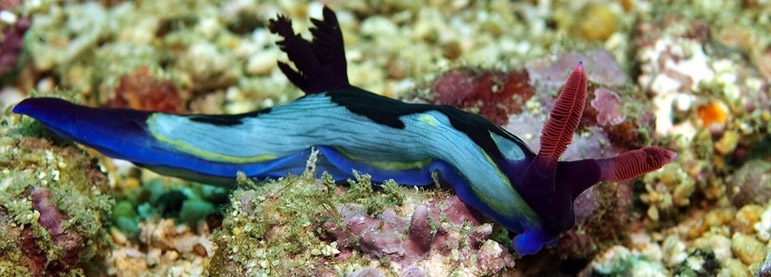 |
Nudibranch – Nembrotha Chamberlain’s |
|
|
|
|
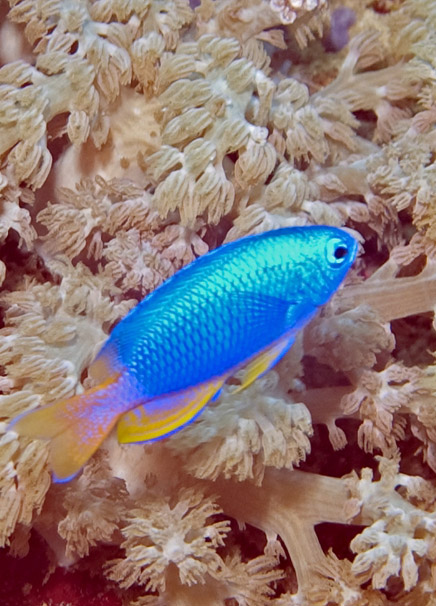 |
Andaman Damsel in soft coral |
|
|
|
|
Puerto Galera
Puerto Galera has been a trading center from the 10th century. In 1927, Puerto Galera became an independent municipality.
In 1973 the area was designated a Man and Biosphere Reserve of UNESCO. It has some of the most diverse coral reef diving in Asia.
The marine environment has benefited in recent years from the influx of tourist dollars. This has resulted in a reduction in the number of fishermen as they gain higher revenue from tourists. Puerto Galera is the only bay in the Philippines to be listed by the Club of the Most Beautiful Bays of the World.
The City and diving accommodations are on the tip of Mindoro Island. There are sheltered bays, each with its own beach and diving operations. Among the famous beaches are Sabang Beach and White Beach, with numerous bars and restaurants. There are also first-class and economy-class accommodations. One of the First-Class is Atlantis (hotel, restaurant and diving) on Sabang Beach. I loved my two weeks here.
Puerto Galera also has a large central Catholic Church and pier area with bistros and cafes. Diving, eating / drinking and sleeping are the main activities. This reflects my experience – dive/eat/dive/eat/dive/eat/dive/drink-eat/sleep.
|
|
|
|
|
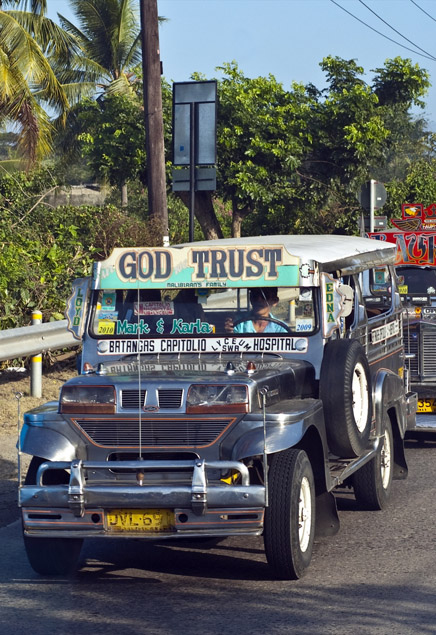 |
A local Taxi with prayer and advertisements |
|
|
|
|
Diving Puerto Galera
Puerto Galera is among the top diving destination in the Philippines. There are more than thirty dive sites all within 5-10 minutes from Sabang Beach. Marine life is highly diverse. More than 180 species of nudibranchs have been reported and the number of fish species is enormous. Wrecks have been sunk over the years in addition to one wreck with the engine of a WWII Japanese patrol boat.
Atlantis, Puerto Galera – Built for divers by divers!
What makes Atlantis special?
I interviewed the Dive operation Manager, the Resort manager and one of the owners, who all said something like a portion of their mission statement.
“The people, you come first in everything we do, whether it’s your honeymoon, your first time on scuba or a dedicated photo dive for the most experienced divers. Our resort team has decades of experience in all areas, but what makes us stand out is the way we make you feel. When you return, which we are sure you will… it’s just like coming home. “
My experience confirms the philosophy. By day two every staff person knew my name and by day two everyone knew my preferences (cheese and tomato omelet for breakfast, cressie BC with worn out blue weight belt, the Australian red not the California).
|
|
|
|
|
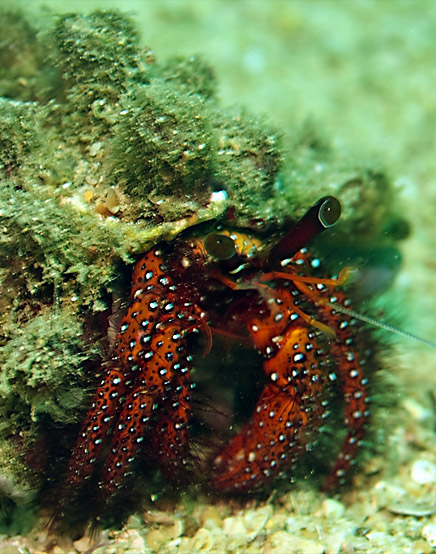 |
White spotted hermit crab |
|
|
|
|
|
|
|
The other point stressed by all three was safety, in and out of the water. There were always one and often two guides in the water. Several dive guides had been former boat captains at Atlantis so when the boatman was busy helping divers into the boat the dive guide could run the boat as needed.
We were a group of experience underwater photographers – THE WORST DIVERS FOR DIVE GUIDES. We half listen to the briefing, jump in and look for the first subject and stay there long enough for the rest of the group to be in another ocean and then we look for the next critter. Buddy – what Buddy? Fifty minutes bottom time, are you kidding 50 pounds of air is the more likely limit.
During three to four dives a day I watched as the Atlantis dive guides maintained underwater contact with divers by staying above and moving between divers, even in murky water. It was the exception when we were all on the boat waiting for the stray diver. When I would look up from my subject in murky water I only needed to make a small circle before spotting the guide – who usually had another interesting subject to photograph.
This is a very professional team. They got us as a group but adjusted to our individual needs. They were on top of all the details from handing down the right camera rig to each diver to knowing who had missed the gurnard lionfish last time around. If a diver hadn’t analyzed and taped off a nitrox tank it didn’t go on the boat. However, before that occurred, one of the staff would find the guest and remind them to analyze the tank.
This is a great place for photographers as there is very roomy camera room with great lighting, compressed air and storage tables for bags and extra camera gear. The lodge is about to make the camera room larger and more convenient. |
|
|
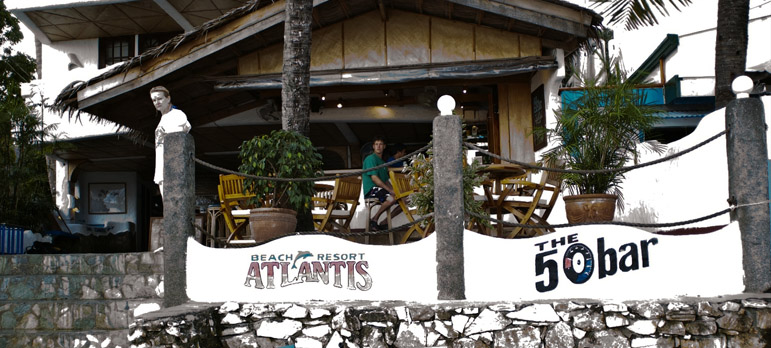 |
The beach bar at Atlantis Dive shop |
|
|
|
|
|
|
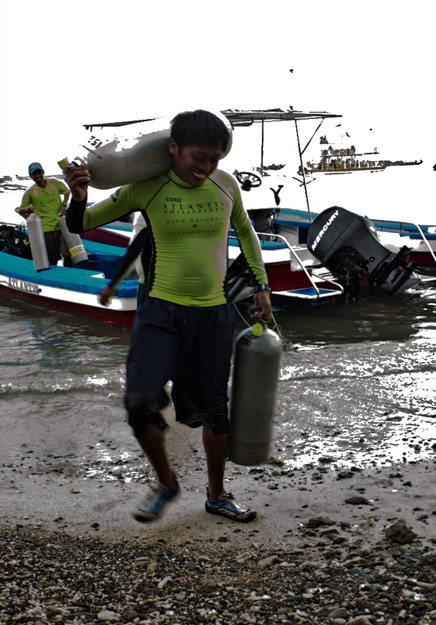 |
Boat Capitan unloading tanks at Atlantis Divers |
|
|
|
|
|
|
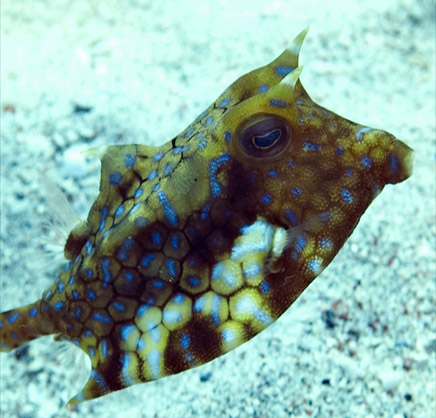 |
Juvenile Longhorn Cowfish |
|
|
|
|
|
Before I detail the dives, let me mention that staff found us easily because we were reliably in the restaurant or the bar where the meals were varied, often creative and beautiful, and all delicious. Not for nothing does Lonely Planet give Atlantis's restaurants a world-class ranking.
Dive Sites (Thanks to Atlantis for Descriptions)
Manila Channel (Depth: 15-65ft, Time to Site: 10 minutes)
The dive starts in 15ft and the reef slopes off to a sandy bottom at about 50ft. There are antheas, damsels and butterfly fish everywhere. This is a beautiful reef it is covered in growth- potato coral, large purple gorgonian sea fans, green tree corals, large barrel sponges and long whip corals, which often have commensal shrimps living on them. The sandy bottom is home to fire urchins and mushroom corals. Cuttlefish are here, including the rare flamboyant variety, as well as lionfish and scorpionfish. And, since this is a channel, you can do it as a drift dive with the direction depending on the tide. We saw the Flamboyant cuttlefish but the buzz on the boat was the beauty of the soft coral as we drifted above it.
Coral Gardens (Depth: 15-45ft, Time to Site 10 minutes)
The name gives it away – a great dive for beginners and photographers, as well as for snorkelers. Coral Gardens is classically, Pacifically beautiful with large coral heads on a white sandy bottom. Between the coral heads, the giant plate corals, the staghorn corals and barrel sponges you will find soft corals. Coral Garden has lots of reef fish - antheas, parrotfish, and schools of sergeant majors, damsel fish butterfly fish and angel fish. In the sand and under outcroppings you will find gobies, lizard fish, shrimps, scorpionfish, juvenile lionfish and the occasional grouper. This can be a very easy dive – but also an exhilarating drift!
I dove this on a sunny morning and spent most of the dive at 15ft photographing fish and coral in nearly natural light.
Big LaLaguna (Depth: 15-60ft, Time to Site: 5 minutes)
Big LaLaguna is an easy dive site for beginners. The white sandy beach extends into the water and is a perfect place to start an easy dive. On the edges of the sand are both hard and soft corals teeming with reef fish. Big LaLaguna also has many species of anemones with different kinds of anemone fish. I photographed five different species with different anemones within a few feet of each other. The sandy beach is more than just sand - flounders, shrimps with their gobies, pufferfish, pipefish and schools of juvenile cat fish can be seen on the sand.
Sabang Wrecks (Depth: 45-55ft, Time to Site: 1 minute -- Not a typo – ONE minute.)
Sabang Wrecks is one of the most famous dive sites in Puerto Galera. It is the photographer’s and macro lover’s Mecca.
The three wrecks - a small steel yacht and two wooden boats in different stages of decay – host more life than you can see or photograph. There is a school of batfish near the wrecks. They attract lots of smaller damsels, butterfly fish and surgeon fish. There are as numerous camouflaged scorpion fish and stone fish living on the wrecks. Under the wrecks you’ll find giant moray eels, lionfish, crabs and shrimps as well as schools of cat fish and squirrel fish hiding during the day. Stargazers are common here, as well as snake eels, flounders and pipefish. Frogfish can be found on the wrecks and on the sand. With a great guide, you might also find robust ghost pipefish, ornate ghost pipefish, moth fish, flying gurnards and leaf fish trying to blend into the sand.
And, if this isn’t enough come back for a great night dive when the shrimps, hermit crabs, horse shoe crabs, sponge crabs and decorator crabs, cuttle fish of all varieties, squids, pleurobranchs, flatworms and moray eels out hunting for food,
Kilima Steps (Depth: 15-85ft, Time to Site: 9 minutes)
A fantastic dive for the diversity of the fish and coral found here. Starting in shallow water, the dive site consists of flat areas broken up by small walls – ridges – at all depths, with the deepest one in 30 meters. The reef is literally teeming with life, with schools of antheas, surgeonfish, angel fish, butterfly fish, parrot fish and all the other common reef fishes. Moray eels are very common. You can find one or two under many coral heads or rocks, often with different species sharing a hole. Frogfish and banded sea snakes, turtles and octopus also frequent the area. Emperor fish very often speed past on their way to find a pray. Pygmy seahorses have always been common here and this is the only place in Puerto Galera where you can admire the beautiful palette surgeonfish - “Dory” from “Finding Nemo”)
|
|
|
|
|
|
|
|
|
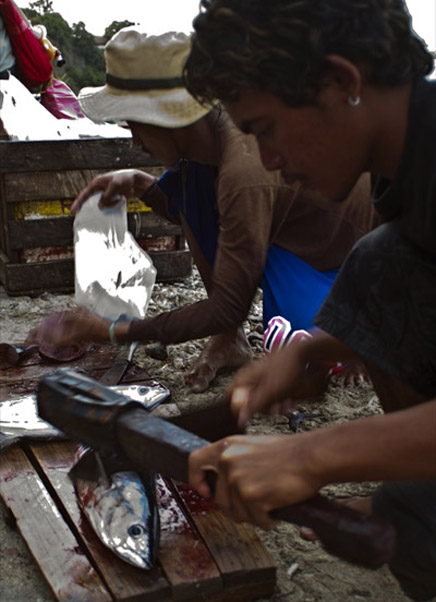 |
Local Fish Sellers on Sabang Beach |
|
|
|
|
|
|
|
Sinandigan Wall (Depth: 15-85ft, Time to Site: 12 minutes)
Nudibranch heaven! Sinandigan Wall is a rocky slope with by two walls, ongoing down to 85ft. Hundreds of nudibranchs flourish on the walls. On the same dive, you’ll encounter harlequin sweetlips, an occasional leaf fish, warty frog fish, crocodile fish and almost every anemone fish.
Once you leave the walls and go shallow, you will find an impressive variety of hard coral and mushrooms coral all the way into shallow water.
I photographed at least a dozen different species on one wall.
Coral Cove (Depth: 15-25m (Time to Site: 13 minutes)
Coral Cove is a wonderful dive site for macro lovers. A sloping reef ends in a small wall at. On the slope, you will find countless nudibranchs, whip coral, sea fans, puffer fish and often cuttle fish. The wall, and its overhangs, is home to some unusual critters – blue and black ribbon eels, juvenile emperor fish, pipefish, and orangutan crabs hiding in bubble coral, flamboyant cuttlefish and frog fish. Banded sea snake is common here, as are blue spotted sting. You might find thorny sea horses hiding in the rubble. Actually we found three in the sand.
Monkey Beach (Depth: 15-55ft Time to Site: 3 minutes)
A coral slope down to 55ft makes this an easy dive, except when currents are running – you can pick up quite a lot of speed here. In the middle of the bay you will find a wreck at 50ft, tilted to the side. Many frogfish make this area their home. The mantis shrimp, they are very common here. I photographed two species. Of course, many of the shots were of tails as they ran for cover.
Boulders (Depth: 15-85ft, Time to Site: 15 minutes)
At the surface you face a vertical stone wall and a few large boulders breaking the surface. As you descend underwater, down the slope, the site is covered with different shaped and sized boulders that look like they have rolled from the cliff and have come to rest on the slope, creating swim-throughs and caves and lots of hiding places for marine life. This unusual dive site doesn’t sport the lush vegetation and colorful corals of other dive sites. However, the dramatic rock formations, black coral formations, schools of snappers hovering over the reef, lots of nudibranchs and often ribbon eel and cuttlefish provide plenty to see and photograph. I photographed a pair of yellow warty frogfish at this site.
Dungon Wall (Depth: 15-85ft, Time to Site: 6 minutes)
From a beautiful hard and soft coral slope, you’ll find yourself on a pretty wall starting at 35 feet and continuing down to 70 feet. The wall has plenty of cracks and crevices with lionfish, scorpionfish and porcupine fish hiding in them. The wall is also famous for its assortment of nudibranchs and flatworms. This is a great site for moray eels: white eyed, clouded. If you see a black crinoids looking bulkier than normal it’s probably a frogfish. When you go deeper you will encounter the wreck of an old sailing catamaran. Inside the hulls are ringed pipefish, lionfish, puffer fish and many species of juveniles. On your safety stop in the shallows, you will find big carpet anemones inhabited by porcelain crabs as well as anemone fish.
I selected to review these ten sites not because they are the best but rather to provide a sample of the diving. I didn’t dive a bad site. And, my dives included a large sandy bottom with murky water and some boat traffic. Maybe it wasn’t beautiful, but it was very productive with dragon seamoth, the wonderpuss octopus, spiky seahorses, several species of shrimp and blue winged lionfish.
A Day at Verde Island
Verde Island Drop Off (Depth: 15-190ft, Time to Site: 45 minutes)
Verde Island is an underwater mountain piercing the surface and then dropping down to great depths. The Drop Off at Verde Island is a huge and spectacular dive with breathtaking views and marine life.
You drop into shallow water next to the wall and follow it down towards 90ft. The slope is covered with fan coral, sponges and schools of thousands of juvenile triggerfish, butterfly fish and antheas. The reef is covered with gorgonian fans, banded sea snakes, scorpionfish and the schools of small reef fish, making it difficult to actually see the surface.
The reef has fat nudibranchs crawling everywhere. Sponges are everywhere and they are the preferred food for nudibranchs.
Most of the time the current makes it impossible to get around to the other side of the drop. The other side has amazing soft coral fields with schools of sweetlips, longfin bannerfish and sergeant majors. At the safety stop you will be in awe of the lively and colorful reef at 15ft. Most of the time there are barracudas patrolling just beneath the surface.
This is a gorgeous dive site but not for the inexperienced. The current can be very tricky and blow you off the wall, and down currents are common – as are up currents which will propel you to the surface. Stay behind your guide at all times.
The back side of Verde is a large bowl with sheltered diving. It is loaded with fish which causes the pelagic predators (i.e. Jacks) to come in for snacks.
The lodge provides a great lunch on the Island. There is a bathroom and opportunities to buy souvenirs.
Atlantis Dive Resorts which owns Puerto Galera also has a resort in Dumaguete and runs the Azores liveaboard. I hope to make one or both of them my next Pacific dive trip.
|
|
|
|
|
|
|
Before Atlantis’ Technically Diving Operation
Atlantis Tech was founded by expert deep diver John Bennett. John held the record for the deepest ever open ocean dive on scuba and was the first diver on scuba to cross the four minute mile of diving, by descending past 1000ft/300m. An intense dedication to technical diving of all kinds led John to the top of his field, continually striving for more knowledge, understanding, and ability.
John died on a salvage dive in Australia. Before he left to pursue his salvage career he trained and handed over the reins to Matt Reed, the current manager of Atlantis Tech.
Atlantis Tech Philosophy In-Brief
The Atlantis website says this about Tech Diving, “We teach Technical Diving, we do not sell certifications”. This sums up their philosophy. Emphasis is not placed on issuing certification cards; Atlantis will work with you, until you possess the knowledge, confidence and skills required at each level. The result is training that you won’t find at other dive stores.
The current team was trained to ensure the continuation of the philosophies which give the technical diver the edge in a demanding environment. They don't teach just from books – real technical divers with real experience, and real passion for the ocean is what you will find at Atlantis Tech.
Atlantis tech has high quality facilities and equipment. Their experienced staff is dedicated to safety, enjoyment and the development of divers. They run training at all levels through IANTD and DSAT. The full time instructors have decades of diving experience, have logged thousands of technical dives, and certified over a thousand divers. Three of the technical sites are described below.
Hibo Reef (40m to 100+m) Time to Site: 30 minutes
Due West of Puerto Galera is a stunning drop off. Hibo Reef drops from 30m to at least 100m in places. The sheer face makes for an exhilarating 76m dive, gazing down to a distant bottom with a full forty meters of wall soaring above you.
Monkey Wreck (40m to 45m) Time to Site: 5 minutes
A 30 meter wooden wreck lying close to Monkey Beach was sunk through a joint effort of several Puerto Galera dive shops. Although the structure of the wreck is mainly collapsed, it has become a home for scores of fish. Several large Bat Fish, Sweet Lips, Barracuda, Cod and Snapper can be seen around the timbers. There is also often a large school of black and white catfish there, with one particularly cheeky chap that likes to come out and have a look at you for a change.
Marcus Cave (48m) Time to Site: 30 minutes
To get to this site requires a blue water descent to the top of a wall in 40m which is covered with whip corals and sea-fans. From there you drop down the face which bottoms out to a sandy bottom in 55m. There, at the western tip of the wall, is the opening of the cave. It is as wide and deep as a three-car garage so there is plenty of room to explore the inside. You will find a large gorgonian that hangs from the ceiling of the cave, and the brilliant colors of the soft tree corals come to life in the beam of an underwater light. A home to a multitude of cleaner shrimp and wrasse this site attracts all marine life for daily cleaning – you never know what you might see!
The minimum depth of this dive site is 40 meters and the maximum depth is 60 meters. Marcus Cave dive site requires a certification in DSAT Tec Trimix Diver with which you can deep dive up to 75 meters. This course requires you to have a PADI Rescue Diver certification, to be 18 years of age and to have a DSAT Tec Deep Diver certification and you have to have a minimum of 150 logged dives. This dive will require you to use a trimix blend of helium, oxygen and nitrogen.
For more on Atlantis’ technical sites.
https://www.atlantishotel.com/tech/tech_divewithus_local.php
Would I Go Back?
Absolutely! With great diving ten minutes from the dock, great food, and stellar dive crew, restaurant and kitchen staff, front desk attendants, housekeeping, gardening folks, as well as an interesting small town: going back is a must.
|
|
|
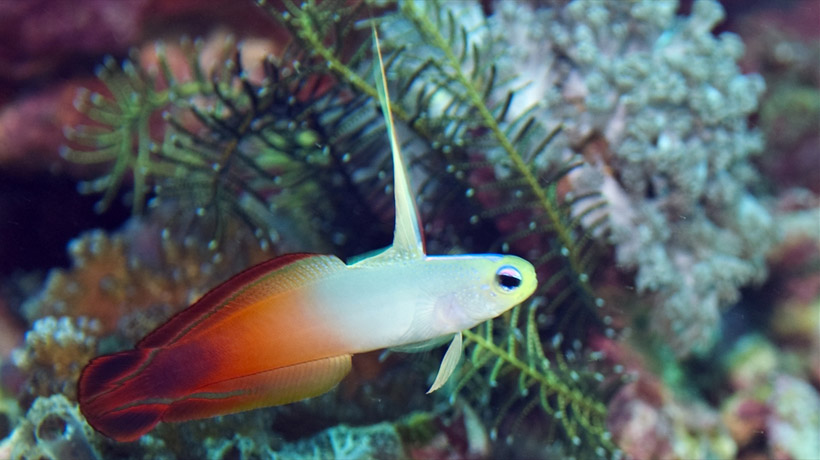 |
|
|
|
|
| |
|